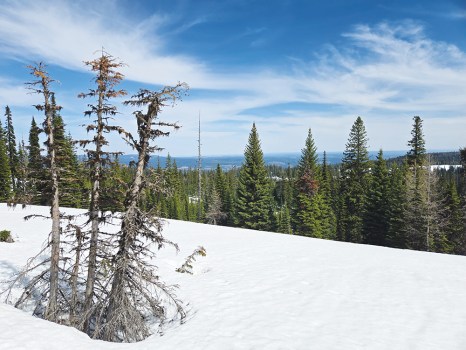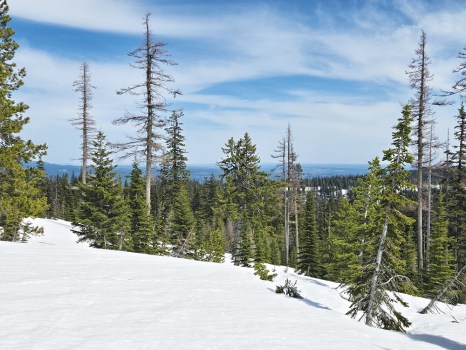Out and About: The great swindle of spring snowshoeing
Published 7:22 am Thursday, April 17, 2025
TOLLGATE — Spring snowshoeing is cheating.
This is no terrible transgression, to be sure.
Nothing that would lead to a prosecution.
It’s more akin to dunking on an 8-foot hoop, or competing in a spelling bee while holding a dictionary.
The unique nature of snowshoeing in spring has to do with the physical properties of snow.
Freshly fallen snow in Northeastern Oregon, particularly during winter, tends to be light and powdery — more like talcum powder than porridge.
This soft, insubstantial snow gives way at the slightest touch.
Snowshoes, of course, are designed to offset this. It’s a matter of physics — the larger surface area of snowshoes, compared with plain old boots, means there’s less pressure exerted on the snow.
Where a boot plunges, a snowshoe “floats.”
Well, not exactly.
The advantage that snowshoes confer varies dramatically depending on the consistency, and of course the depth, of the snow.
The benefit can seem negligible when you’re trudging through a couple feet of new snow, sinking to knee level with each step.
It can be exhausting.
By April, though, the situation tends to be quite different.
The combination of higher temperatures and the daily freeze-thaw cycles changes snow from powdery to grainy — something you might cram into a paper cone and slather with sweet syrup in one of those headache-inducing shades that only chemistry can concoct.
This consolidated snow is firm.
So firm that snowshoes can seem superfluous.
It was the prospect of a less taxing snowshoe hike that brought me to the northern Blue Mountains on April 15.
(That it was also Tax Day was purely coincidental.)
The Tollgate area along Highway 204 is an ideal place for spring snowshoeing.
Despite its middling elevation by the standards of the Wallowa, Elkhorn and Strawberry ranges to the south, the northern Blues concede nothing to those loftier mountains in snow depths.
Winter storms that sweep inland from the Pacific tend to be channeled, as it were, by the Columbia Basin directly at the ramparts of the northern Blues. Snow often is deeper at 5,000 feet — the highest point on the highway is 5,158 feet, near Spout Springs — than at 7,000 feet in the Elkhorns or Wallowas.
And unlike much of the mountainous country in Northeastern Oregon, the Tollgate area is readily accessible thanks to the highway and several sno-parks.
(An Oregon sno-park permit is required to park at these sites through April 30.)
Snow can fall well into spring in the Blues, but the Tax Day weather was ideal, with sunshine and a temperature of 55 when I parked at the Woodland Sno-Park. Woodland is between mileposts 24 and 25, about 17 miles from Elgin, the southern end of Highway 204, and about 24 miles from Weston, the highway’s northern terminus.
Other nearby sno-parks include Andies Prairie, which is south of Woodland, and Spout Springs and Morning Creek, both to the north.
The temperature was nearly ideal. It wasn’t warm enough to turn the snow to mush that sticks to snowshoes as tenaciously as corn flakes fused to a cereal bowl left overnight in the sink.
But the air was sufficiently mild for the other type of cheating that spring snowshoeing allows — going in shirtsleeves.
The challenge during winter is finding the balance, in terms of garments, between being bathed in sweat and constant shivering. Floundering in deep powder is intense exercise, and when your body is burning calories rapidly it’s also producing quite a bit of heat. Even with an air temperature in the teens, the typical winter layers of fleece and wool and goose down can be cloying.
Until you stop for a rest or a snack. The chill begins to creep in immediately, seemingly transforming sweat to ice.
Winter snowshoeing can devolve into the sort of costume changes typically seen behind the curtain during a Shakespearean play, shedding and donning layers as the conditions, and your comfort level, dictate.
I had no such distractions to deal with as I strapped on my snowshoes.
The Woodland Sno-Park is on the west side of the highway, almost directly opposite a campground named, appropriately enough, Woodland.
With 6-foot-high snow berms still lining the highway, I appreciated that snowmobilers had created a sort of ramp at the campground entrance. I walked past the campground sign, which must have only recently emerged from the receding snow, and struck out east through the forest.
I climbed the ridge that rises about 200 feet above the highway and roughly parallels the road, leading north to Spout Springs. The snow was pleasantly firm but the surface soft enough that the plastic decks of my snowshoes didn’t clatter. Snowshoeing on any icy crust can create the sort of cacophony normally limited to minor explosions at factories that make cymbals.
I reached the crest of the ridge, where openings in the forest — what will be meadows once the snow’s gone in another couple months — yielded suddenly expansive vistas.
All mountain ranges are, to an extent, islands, surrounded not by water but by lower terrain. But this part of the northern Blues has always seemed to me to exemplify the sensation. In all directions the land falls away to places where, by mid-April, spring is ascendant.
On the west the great canyon of the North Fork Umatilla River, its south slopes already free of snow, descends steeply toward the Columbia Basin.
To the north lies the vast Palouse, where the dominant color is not white snow but green wheat, and to the south the Grande Ronde Valley, wedged between the Wallowas and the Blues and where the crops are also coming on.
East of where I stood the land plunges to the canyons of Lookingglass Creek and its tributary, Eagle Creek. There, too, south-facing aspects were bare.
Yet on the ridge the snow, based on the depth of the wells around the trees, looked to be six or seven feet deep. The only suggestion of spring was the soft air and the sunshine, which had a power it utterly lacks in January.
I meandered through the trees, generally bearing west, back toward the highway. I noted something else that distinguishes the northern Blues — the forest, a mixture that includes lodgepole pine, Engelmann spruce and subalpine fir, resembles what grows at much higher elevations in the Elkhorns or Wallowas.
That evening, while I was driving back to Baker City after watching my daughter Olivia’s tennis match in Milton-Freeway, I chose the slightly slower, but much more engaging route through Tollgate rather than the efficiency and mindless motoring of Interstate 84.
The temperature dropped from 72 at Weston to 48 near Spout Springs, a span of just 21 miles.
This struck me as another way, along with the snow and the forest, to distinguish this place as a sort of aerie, an alpine archipelago in an otherwise arid region.
I turned off the air conditioner.











